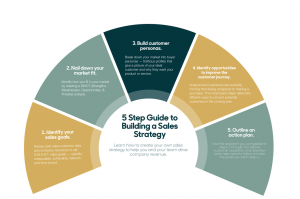
How to create an effective sales plan and present it: components and tips
Any business involves sales, and forecasting and planning are some of the major activities for a sales team. In this article, you will learn what a sales plan is, how to create an effective one, and how to make a sales presentation PowerPoint based on this plan. We will also discuss some sales plan examples.
What’s sales plan, and why do you need it?
A sales plan is a part of an extensive sales planning process. It helps forecast the sales success a business wants to achieve and outlines a plan to help it accomplish its goals.
Here are the reasons why you need an effective sales plan:
- It helps foresee risks.
- It makes it easier to track company goals.
- It helps find any bottlenecks in the process.
- It helps set clear revenue targets to achieve within a specific period.
- It helps improve lead generation efforts.
- It helps unify labor policies and ensure consistency in operations.
- It helps understand the business’s strengths and weaknesses.
- It helps track progress.
- It helps identify sale strategies that match the target market.
- It helps evaluate the sales team’s performance.
- It helps define each salesperson’s role and delegate work.
- It helps lay out tactics to execute the sales team’s strategies.

Sales plan structure
A sales plan outline will help you present critical metrics, KPIs, processes, tools, objectives, and strategies necessary to hit your sales goals.
If it is your first time creating a sales plan, below are the sections that must be included:
1. Your target revenue
In a sales plan, you can set a revenue-based goal, such as a target of $10,000 in 5 new deals in one month or $150 million in annual recurring revenue. You will need to keep that revenue target achievable.
Here are a few tips for setting your target revenue:
- Determine a reasonable sales goal according to prior sales results and your ability to reach a new market.
- Calculate the anticipated expenses for a specific period.
- Use projected sales forecasts based on estimates or industry standards.
2. Your ideal customer profile and buyer personas
To establish the target market or ideal customer, you must create a series of unique customer profiles that include geographics, demographics, job positions, behavior, and interests. From there, you can clearly define buyer personas and develop more targeted marketing and advertising strategies.
3. Your sales team
A sales team plays a vital role in implementing any sales plan. You must clearly delegate roles and responsibilities to the sales managers, customer service representatives, account executives, sales development representatives, and other sales professionals.
What’s more, there should be smooth communications and a handoff process. You can even consider using a Customer Relations Management (CRM) system to bring visibility and transparency to the sales process for all team members.
4. Your resources
Is your team small? Then, it would help if you determine how to expand the team to meet the sales targets and state how many resources are necessary within a specific period in your business plan.
You may also utilize specialized sales software for effective sales operation management. One such tool is snov.io, which helps scale a small business while engaging better quality leads with the product or service.
5. Safety of communications
Effective communication is essential in a sales team as it keeps each member productive, engaged, and informed. It also performs the following functions:
- Provides analytics needed to measure engagement with sales goals and benchmarks.
- Encourages marketing and sales teams to collaborate on projects.
That’s where you need to ensure the security of your communications and take advantage of dialpad.com, a workspace dedicated to team and customer communications. It is designed for global teams, where they can safely and efficiently communicate through voice, video, and AI contact centers.
6. Your position on the market
Position on the market is about competition, market trends, risks, and predictions. It outlines what your company must do to market your products and services to your target customers.
If you know how to position your business on the market, you will have a big picture of how you can establish the identity or image of your brand. It also allows you to achieve superior margins for the product or brand relative to competitors.
7. Your prospecting strategy
Prospecting strategy involves how you will generate quality leads and what inbound and outbound methods your sales team will use. Your goal here is to create interest and convert it into a sales meeting.
Below are easy ways to start your prospecting strategy:
- Build a list that includes who your sales team wants to generate meetings with.
- Research your prospects to ensure your new leads are a good fit.
- Craft your offer to drive value.
- Create a prospecting campaign to generate appointments with potential buyers and include a solid value-based offering.

8. Your pricing strategy
Your sales plan’s pricing strategy is about determining how you plan to change the price of your product and within what period. It will help you choose prices that maximize your shareholder value while considering the market and consumer demand.
Pricing strategy accounts for many business factors, such as product attributes, brand positioning, target audience, marketing and revenue goals. It is influenced by external factors, such as economic and market trends, competitor pricing, and consumer demand.
When creating a pricing strategy, consider the following:
- Pricing potential evaluation
- Buyer personas
- Historical data
- Your business goals vs. value
- Competitor pricing
9. Your goals, objectives & DRIs
Goals often include one to three- or five-year projections. Your goals must reflect recurring or existing customers’ expected sales and revenue. Then, you will need to have sales objectives that prioritize the activities your sales team needs to engage in.
Assigning Directly Responsible Individuals (DRIs) also helps make a successful strategic sales plan. These individuals are typically responsible for making sure particular tasks are well-executed.
10. Your action plan
Part of creating an effective sales plan is defining your action plan. It deals with summarizing your plan to achieve each specific objective. For instance, if your sales goal is to increase your referrals by 20%, your actions would be:
Holding referral technique workshops
Running a contest to boost referral sales
Increasing referral sales commissions by 5%
11. Your budget
In this section, you must outline all costs you believe will be required to achieve your sales targets. Some expenses include hiring, printing, travel, training, sales tools, commissions, salaries, etc. These expenses are meant to be estimates, but due diligence and research should be done to prevent financial errors.
Sales plan examples
When it comes to creating a sales plan, there is no unified sales plan template. Each sales plan differs based on the company’s purpose. While you can encounter different sales plans, here are the common ones:
1. 30-60-90-day sales plan
A 30-60-90-day sales plan is milestone-based. This means it specifies a short-term goal you must achieve within 30, 60, or 90 days. This type of sales plan is suitable for new sales managers, helping them establish tactical and strategic activities according to this plan.
2. Territory sales plan
A territory sales plan features tactics dedicated to the sales team in different territories. You will need to consider a specific area’s market dynamics and working environment.
With a territory sales plan, you can:
- Target specific customers, opportunities, regions, and industries.
- Align the sales team with the prospects.
- Set realistic goals, optimize the strategies, and track progress.
- Spend more time selling.
When creating this sales plan, you have to:
- Define larger sales goals.
- Define the target market.
- Assess account quality and prospects.
- Map out the sales representatives’ strengths and weaknesses.
- Assign leads.
Polish your plan.
3. Sales plan for specific sales
When it comes to this sales plan type, you must familiarize yourself with different sales domains, such as sales training plans or compensation, as well as:
- State the company’s mission
- Set objectives and timeframe
- Define the sales team
- Define the target market
- Evaluate the resources
- Create a comparative analysis of your offerings
- Set the sales budget
- Define the marketing strategy
- Work out the strategy
- Define the action plan
4. Monthly sales plan
If you prefer a traditional sales plan, you can opt for a monthly sales plan. It features tactics and revenue goals, which have to be accomplished within a month.
5. Sales tactics plan
A sales tactics plan includes execution strategies. It also involves detailed daily or weekly plans, including prescribed call sequences, meeting appointments, and email follow-up frequency.
Tips on how to create a sales plan
Are you looking for effective recommendations on how to make sales plan for your company? Then, check out the following:
Tip #1: Back up your plan with research and statistics
It is advisable to always back up your sales plan with research and statistics. This will help you define the sales team’s tasks needed to better meet your sales goals. These tasks should primarily stem from statistics and research.
Tip #2: Use SWOT analysis to analyze your capacities
From a sales perspective, SWOT (strengths, weaknesses, opportunities, and threats) analysis will help assess your company’s position in the market. It will also allow you to gain insights into leveraging your selling points, acquiring market shares, and comparing your business’ position with that of your competitors.
To make this easier, you can use a visualizing tool to document the results of your SWOT analysis. You can choose from flow-chart tools, spreadsheet apps with SWOT analysis templates, mind mapping software, SWOT analysis generators, or online presentation or graphic design tools.
Tip #3: Split your sales plan into specific tactical plans
You can use specific tactical plans to achieve your sales goals. The details depend on different variables, such as resources and time. You can make a plan for individual areas of sales, such as SDRs, sales enablement, sales operations, and customer success.
As you create a tactical plan, you have to consider the following key elements:
- Company mission
- Timeline
- Objectives
- Key performance indicators
- Flexibility
- Action items
- Responsible parties
- Resources
These key elements will help you identify the plan’s success in many ways, including the likelihood of accomplishing it.
Tip #4: Use previous performance data
You can use previous performance data to build incentive, territory, quota, and sales capacity plans. Using this data as your crucial decision-making tool, your sales team can have a basis for making informed decisions and forecasting performance more efficiently and accurately. In return, your sales plan will likely help achieve efficiency, higher performance, and bottom-line growth.
Tip #5: Outline the tracking methods you’ll use
By outlining tracking methods, you can set process workflows, allowing your sales representatives to determine where each prospect stands and which steps they need to take next.
You can also track the following:
- Sale cycle length.
- Number of closed deals.
- Conversion rate.
- Average contract value.
- Pipeline value by quarter, by month, and by individual and team.
- The number of unclosed deals after reaching a specific stage.
Now that you know the peculiarities and components of a sales plan, let’s find out how to make a sales plan presentation, what to include in it, and discover the top 14 sales presentation tips from vetted professionals.
What is a sales deck, and how to best present one?
A sales deck is a set of slides you can use to guide your audience through your sales strategy presentation.
Slide presentations can help your target audience grasp crucial information, pricing, and product characteristics your sales representatives can build their story around.
The best sales presentation slides serve as a touchstone for your sales team’s pitches. They allow your sales managers to draw on their personal knowledge to deliver additional information tailored to the prospects and stakeholders they are presenting to.
What are the types of sales presentation?
Sales presentations are classified into three types: standard memorized presentations, formulated sales presentations, and need-satisfaction presentations. Each sales presentation deck type has distinct characteristics that suit different scenarios.
1. Standard memorized presentations
Standard memorized presentations are very detailed and precise and always follow a predefined structure. They ensure no detail is overlooked and enable the sales team to produce a well-rehearsed, flawless presentation, leaving no room for misinterpretations or potential inaccuracies.
2. Formulated sales presentations
Formulated sales presentations offer a balance between rigidity and flexibility. While they follow a structured sales presentation outline, they allow salespeople to adjust their presentation in real time based on the customers’ reactions. Because of this flexibility, the sales presentation is not set in stone but revolves around customer preferences and queries.
3. Need-satisfaction presentations
Need-satisfaction presentations follow a customer-centric approach, allowing the salesperson to focus on satisfying the customer’s individual demands. The emphasis here is on establishing a dialogue rather than presenting a monologue, encouraging the customer to actively engage in the process.
What are the features of a sales presentation?
The content of your sales presentation PowerPoint must be written carefully and portray the story behind the specific product or service. As time is of the essence in sales, ensure your presentation is no more than 10 minutes and the overall meeting time does not exceed one hour.
When you invite people to come to your sales presentation, make sure they are decision-makers and are related to the things you are selling. Also, try not to lose the prospect’s attention by choosing the wrong points. Your sales presentation doesn’t have to concentrate too much on your service or product. Instead, show the audience how your service or product will change their lives in a good way.

Sales presentation structure
Here’s how to build a sales presentation that catches your audience’s attention and delivers your product’s value proposition in the best way possible:
- Introduce the pain points of your prospects.
- Describe the impact of the problem your prospects are facing.
- Explain why change is urgently necessary and what they stand to lose by not acting.
- Present the solution: a clear path toward the prospect’s goals.
- Provide evidence, address reservations, and FAQs.
To create personalized sales decks quickly, you can use a sales presentation template with the most recent FAQs and case studies. This will allow you to easily copy a deck and create a customized sales presentation for each new prospect in a matter of minutes.
What to include in a sales deck?
Good sales decks have a few key elements, such as:
- Introduction. Say a few words about your company, mentioning your activities and mission. Make sure you grab the audience’s attention with a memorable opening slide or cover image.
- Definition of the problem. Identify the main issues that your company is trying to solve. Provide your audience with some data. Metrics can come from third-party sources or your own sales dashboard.
- Social proof. For instance, you might add quotes and success stories from customers to support your sales presentation. However, you must not repeat the things you say.
- Customized content. Customize your sales presentation for every single prospect so as to build a bridge between your services or product and your audience. In other words, make sure it is personalized.
- Next steps. Include a clear and brief call to action. Offer a few next steps for your potential prospects.
- Visuals. Graphs, charts, and other design elements are all effective techniques to illustrate your point. However, make sure they are simple. Do not overwhelm your sales presentation with too much data; use more visuals instead.
Lastly, make sure that the font (and font size) used in your sales presentation design is legible to everyone in the room.
Other points to consider
1. The product
Demonstrate how your service or product operates in action. Create a perfect environment to showcase how the product works, if it is physical. Utilize technology if it is a digital product. For instance, you might ask your prospects to download the app. In some cases, you might use video as a demo.
2. Handouts
Hand out some materials to your audience. For instance, it might be a QR code or contact data. The information must be clear and to the point. Distribute the handouts once the sales presentation is over.
3. Practice and teamwork
Double-check your sales presentation with a few salespersons. Practice a lot before the actual presentation. Come earlier to make sure everything works well. Also, decide who will say some information during the presentation and who will do certain things to help you.

Expert tips: How to create your sales presentation?
Tip #1: Sync
Your main points must be synchronized with your sales deck. When you present statistics, you should speak slowly. Emphasize your tone of voice when you are talking about pain points. Express relief when you showcase how your company wants to tackle specific issues. Make sure all the questions you ask your audience have straightforward answers or are rhetorical.
Tip #2: Involve storytelling
People like exciting stories related to their daily lives and problems. They will listen to your sales presentation even more attentively if you tell a story that solves their everyday problems.
Tip #3: Avoid using technical slang
In your sales presentation, use general terms that are clear to every audience member. Do not use slang words. Most people in the room might not have a clue about your offering, so the simpler the lexicon is, the better the result.
Tip #4: Emphasize the value of your product or service
Try to demonstrate how your product or service differs from your competitors. Tell about the main differences slowly. Mention how your product or service will make other people’s lives more comfortable. In other words, emphasize their value.
Tip #5: Practice body language
Your body language must be confident during the presentation. Improve your body language by maintaining eye contact and standing straight. It will prove to people that you are interested in communicating with them.
Tip #6: Be funny
Use your sense of humor. For instance, you might play jokes, but you would better not force them. Keep in contact with your prospects by telling funny stories. Make sure everyone in the room is comfortable and relaxed.
Tip #7: Emphasize your expertise
Do not talk too much about your company. You should focus your sales presentation on the field of your expertise instead. For instance, you might demonstrate a slide with logos of the companies that have already invested money in your brand.
Tip #8: Focus on benefits
Emphasize the strong points and tell how your product or service will improve your prospects’ lives. Do not focus too much on the pain points. Make sure your presentation is personal and describe all the benefits they will get. You might also mention the names of people in the room to make them feel valued.
Tip #9: Include research
Add internal and external types of research to your sales presentation. Use statistics or graphs and cut the information into brief pieces for your company to get more authority. Add relevant numbers and examples to demonstrate how you helped previous clients.
Tip #10: Showcase the return on their investment
Tell how your company will master productivity, multiply market share, make more money, eliminate costs, and boost sales. In other words, you should show the results of investments both long- and short-term.
Tip #11: Rehearse
Rehearsing before a presentation will help boost your confidence and smooth “rough spots.” You will also get to know the approximate amount of time needed to deliver your presentation.
Tip #12: Talk directly to your audience
Do not speak just to your slides. Utilize slides to emphasize the things you say. If you fail to do so, your presentation will most likely sound boring. Try to engage every member of the audience. Express yourself by using your hands. For instance, you might ask them to raise their hands if they agree to some of the points.
Tip #13: Add a clear call to action
Make sure your last slide includes a call to action. Add your contact data, but do not go deeply into detail. Know when it is the right time to stop.
Tip #14: Answer the audience’s questions
Your prospects will ask questions, and you have to be prepared to stop the presentation and answer their questions as they appear. Your audience must be sure that you take them seriously. At the end of your presentation, you can also offer a product’s trial, discount, or other incentive to motivate the audience or create a sense of urgency. The main goal here is to make the audience involved.
Lastly, follow sales presentation best practices to ensure a polished and persuasive delivery. This includes maintaining a clear and concise narrative, addressing potential objections proactively, and incorporating compelling storytelling techniques. Utilize engaging visuals to enhance your message and capture the audience’s attention. Practice your delivery to ensure a confident and natural presentation style and encourage audience interaction through discussions.
By adhering to these best practices, you can create a sales presentation that not only increases the likelihood of successful outcomes but also fosters positive connections with potential clients or stakeholders.
Still wondering how to create a sales deck?
Don’t worry—our presentation design service has got you covered! With profound expertise in designing compelling presentations in different software and thousands of satisfied customers from across the globe, it will be a no-brainer for our dedicated team to transform your ideas into a visually stunning, impactful sales presentation. Take the first step towards a winning presentation by reaching out to us today.
Your success story begins with professionally crafted pitch deck slides—let SlidePeak help you make it a reality!



